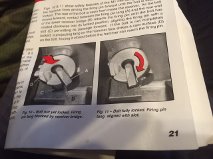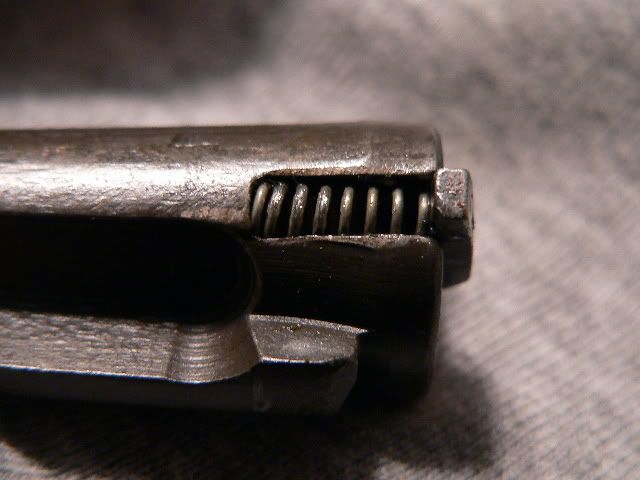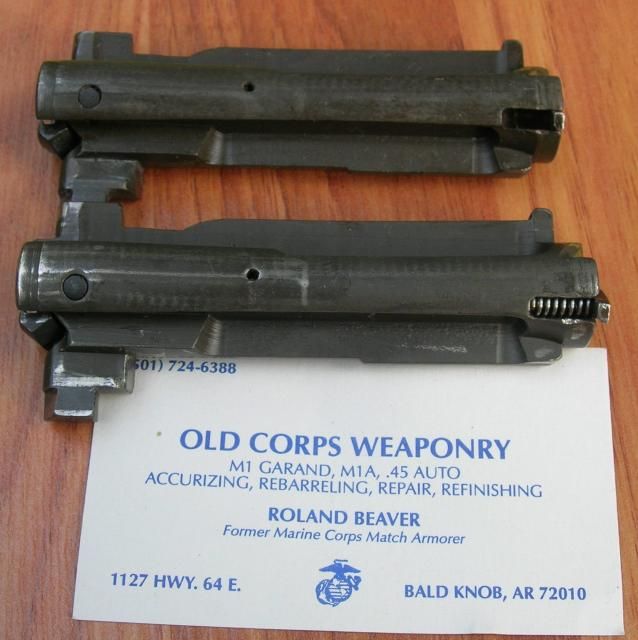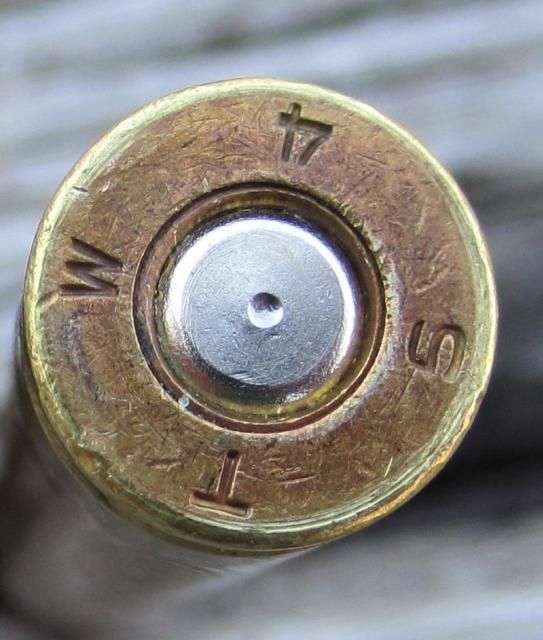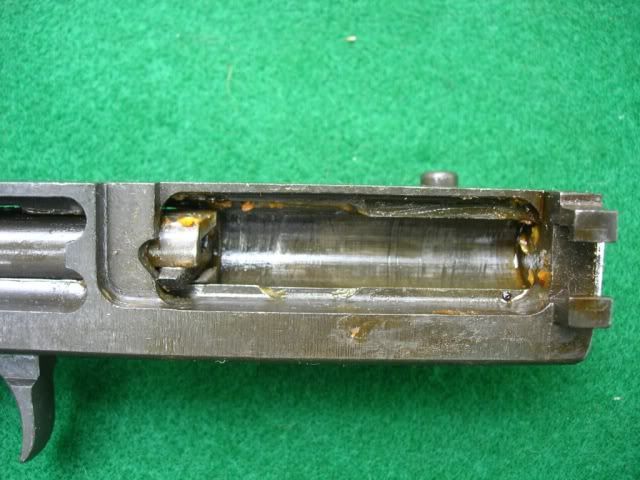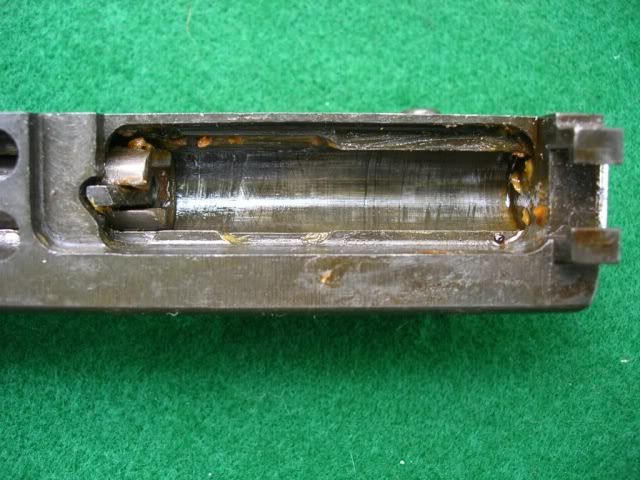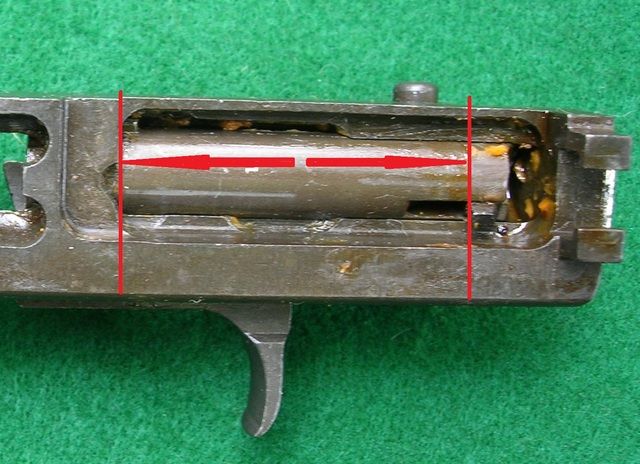I own an M1 and an M1A. Never had any trouble with the latter, and it routinely makes me look like a better shooter than I really am.
I had ONE "incident" with the M1 which, for want of a better definition, I labelled as a "double". On the 6th round through the rifle, it fired, ejected the 6th round, stripped the 7th round from the clip, and fired when the bolt went home. The 8th round was ejected, unfired, in one direction, while the clip was ejected in another. I was SURE that something had destroyed my M1, but it's been shooting like a champ, ever since.
The cause of the "slam-fire" was never determined. Ammo was old factory 150gr., so a high primer doesn't sound right, except that all other explanations made even LESS sense.
I believe you had an in battery slamfire. The violent action after cartridge ignition was due to the lugs not being fully in battery. These pictures are from another poster who nicely gave me permission to use them. This one shows the Garand receiver bridge. Here, the firing pin tang is blocked during final cam down.
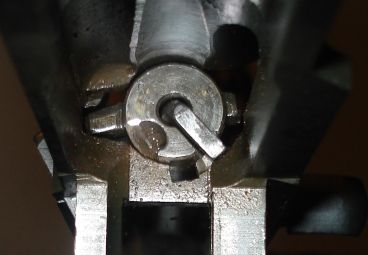
The bolt has rotated enough that the firing pin is able to clear the notch in the receiver bridge.
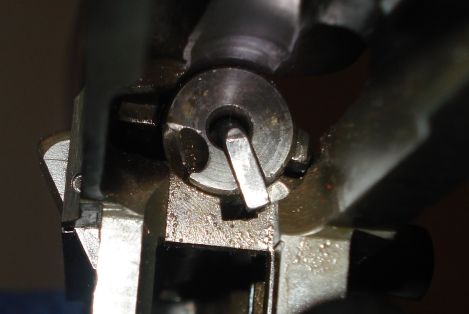
This is the bolt rotation necessary for the tang to clear the notch
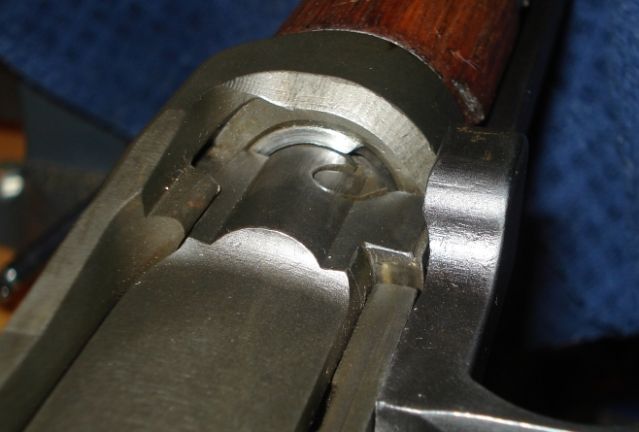
This pencil mark show how little lug engagement there is when the firing pin clears that receiver bridge notch.
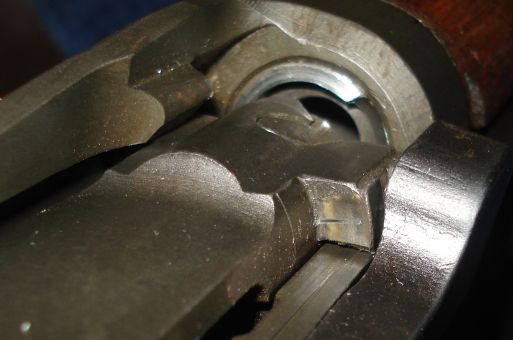
You were lucky. That cartridge had a sensitive primer and had it been one of those neck sized cases, or a fat case, and the bolt had to stop early to crunch fit that round to the chamber, your in battery slamfire might have very well been an out of battery slamfire. As it was, the timing of your rifle was off, due to the fact that bolt was only partially engaged, the bolt was over accelerated on opening and the subsequent slamming and banging caused a malfunction.
The receiver bridge was, and always was, to hold up the back of the bolt and to be a firing pin retraction cam. I am of the opinion that calling it a "safety" bridge is a creation from the early 60's. It is not a positive firing pin block, nor was it ever meant to be. I examined John Garand's' patent, the functions of the firing pin tang and the firing pin retraction cam are explicitly spelled out and not as a firing pin block. Its primary function is to retract the firing pin at unlock. There is a slot allowing the firing pin to go forward when the bolt is in battery, but the function of the piece as a firing pin block is not claimed. The extractor is claimed as a means of holding the firing pin.
Patent 1 892 141 Semi Automatic Rifle. J. C. Garand Dec 27 1932
The firing pin is formed at its rear end with a laterally extending had 72 adapted to contact a projection 73 formed in the receiver when the bolt is in unlocked position so that the firing point is retracted into the bolt, but the head is cut away at 74 to pass such projection when the bolt is locked to permit the pin to be moved to its extreme forward or firing position.
"I claim":
5. The combination with a gun provided with a receiver, of a bolt receiprocable in the receiver, a firing pin reciprocal in the bolt, a laterally extending head for the pin and means in the receiver to engage the head on rocking of the bolt to unlocked position to retract the pin
6. The combination with a gun provided with a receiver, of a bolt reciprocable in the receiver, a firing pin in the bolt, an extractor carried by the bolt, and means on the extractor to prevent rotation of the pin with respect to the bolt.
7. The combination with a gun provided with a receiver, of a bolt reciprocable in the receiver, a firing pin in the bolt, an extractor carried by the bolt, and means on the extractor cooperating with the pin to limit movement thereof.
8 The combination with a gun provided with a receiver, of a bolt reciprocable in the receiver, a firing pin in the bolt, an extractor carried by the bolt, and means on the extractor to limit reciprocatory movement of the pin with respect to the bolt and prevent rotary movement thereof with respect thereto.
Slamfires due to sensitive primers are very rare, but they happen. The kinetic energy of the firing pin must be matched to primer sensitivity or slamfires will occur. Commercial primers are very sensitive, primarily due to all the old, worn out firearms in the hands of the public. When a 100 year old mainspring won't ignite a cartridge, or an inadequately designed ignition mechanism won't ignite a cartridge, the first thing the shooter does is blame the ammunition. Commercial ammunition manufacturers therefore have an incentive to make their primers are sensitive as possible. Given that commercial primers are more sensitive on the average than military primers, the chance exists that a free floating firing pin will ignite a very sensitive commercial primer by chambering a round, or dropping a weapon. If you happen to shoot yourself, have an accidental discharge, or your Garand based firearm goes off out of battery, ammunition manufacturer's have virtually no liability because proving the primer was defective, is a little hard to prove, after the fact.
Slamfire deniers are irrational people, and there are a lot of them. From what I can tell, they fall into four categories:
1) They have never seen a slamfire therefore they do not exist. I have never seen a black swan, so does that prove they don't exist? (they do)
2) They have been taught that only shooter negligence cause slamfires. The US Army taught the American public this nonsense. I call it Davidianism after the last author who wrote an Dobe Bag article in the American Rifleman. The Prime Davidian wrote an article claiming the Garand mechanism was perfect, and that slam fires were only due to shoot negligence. This guy had an amazing background. He worked at Frankfort Arsenal his entire career, he was the Government Technical Expert during the Ichord hearings, and he was the lead into the investigation of the M16 slamfire issue. He created the technical specifications that required a less sensitive primer for the M16 mechanism, the #41 primer. And yet, decades later, when he was retired and working as a Army consultant, writing for the NRA, Army weapons are perfect. Only high primers and your worn out gun cause slamfires. The design of the M1 Garand prevents slamfires, in battery or out of battery, and there is no such thing a primer sensitivity. The concept of primer sensitivity does not exist within his article or any article in the American Rifleman till late. By the absence of information, generations of shooters believe that a primer is a primer is a primer. They believe that all primers from all brands are of the same sensitivity and primer sensitivity does not vary within the lot, or between lots. Generations believe this nonsense, and when you have an authority figures such as the Army and the NRA actively providing dis information by "educating" us that guns can't slamfire by design, well, whom are they to believe, and whom will they believe?
C. Ed Harris was an American Rifleman technical writer from the 70's and he is a Davidian to the core. You can read his post, complete with bold print and spouting specifications, to impress the reader, about how the only thing that causes Garands/M1a's/ mini M14's to slamfire is your "worn out gun and sloppy ammunition."
http://www.thehighroad.org/showpost.php?p=6534244&postcount=7
M1A M-14 slam fire
I have examined several M1 Garand, Ruger Mini-14 and M1A rifles which have slam-fired.
All such incidents I am personally aware of occurred using handloads.
1) While soft primers may be a contributing factor, this is not the sole explanation.
2) If primers are not seated below flush of the case head, protrusion of the primer cup above the case head is a factor.
3) If cases are not sized and trimmed properly, so that there is resistance to full bolt closure and lockup, this is another factor. Both sized cases and loaded rounds should be gaged 100%. Use of military ammunition in minimum SAAMI or custom "match" chambers can also cause tolerance stacking interference.
4) When the rifle is properly assembled, with correct parts which gage properly, the firing pin should be flush or below the bolt face at "half-lock" (7-1/2 degrees bolt rotation on the M14). This is measured using a stripped bolt and slave slide-handle using a dial indicator gage inserted from the muzzle.
5) When M1a parts guns are assembled with surplus parts which may have been rejected because they didn't gage up, this is a big factor.
6) If the firing pin retraction cam in the receiver web doesn't gage properly this is another factor.
7) If the "tail" of the firing pin which engages the receiver retraction cam does not gage properly, this is a factor.
8) If primer pockets are loose from repeated reloads of brass having head hardness less than 170Vickers Diamond Pyramid Hardness, loose primers, or blown primers which leave debris in the bolt face can also cause a slam-fire.
Slam-fires have not to my knowledge been documented in properly assembled rifles in which all parts in the assembly meet the government gages, when using either NATO, US military or SAAMI specification commercial match ammunition, such as M80, L2A2, M118, M852 or Federal #308M.
An exact attributing cause of any slamfire is often impossible to determine because of interaction of multiple variables and the fact that "the Brass Fairy" often removes much of the evidence.
__________________
In Home Mix We Trust
From the Home of Ed's Red
73 de KE4SKY
________________________________________
Last edited by Ed Harris; June 3, 2010 at 09:37 AM.
I used to volunteer at the CMP, I volunteered when they were on Anniston Army Depot, and that has been a while. The CMP Armorers are Garand fan boys, and actively promote Davidianism. They don't believe that their beloved rifle has any defects, believe that only shooter misconduct causes slamfires, and therefore the CMP is Davidian to the core, up and down. It is their culture. You want to be part of that organization you will be required to drill a hole in your head, suck out half your brains, and accept their nonsense as truth. If you are enough of a Garand fanboy, you will. You will happily conform to the group think because you want to be part of the group. When the very top authorities are telling us only shooter negligence causes slamfires, who is going to challenge them that they are full of beans? It turns out debunking authority figures is not something people want to do, it is thankless, and unprofitable. One must also understand the power of "Group Think". Humans are social creatures: we want to fit in the group. We want to be accepted by the group. If the leaders of a group espouse a certain belief system, humans will change their behavior, thinking, and beliefs to fit into the group. Humans will accept the theories of a group, will not challenge the dominant authorities, even when the evidence before their eyes shows that the group theories are wrong.
3) irrational people who don't want to believe that their rifle could accidentally discharge even though they did "everything right". I also believe these types need to feel that nature, the future, has to be 100% predictable, so they won't accept that things happen outside of their control . Many are the
"I said so" types. Something bad won't happen because
"I said so". Pick a situation, there are literally tens of thousands of ways the
"I said so" types have killed themselves or others, because they don't believe accidents can happen to them. The irrational types use every bias and logical fallacy to wish away evidence that the world does not conform to their delusion. These irrational people typically use the most sensitive primers ( Federal) and don't want to change.
4) The fourth category are psychopaths who want to hurt people. An example is Sunray. He purposely gives bad advice, and it is apparent he wants to hurt people.
SKS -- worth it?
http://www.thehighroad.org/showthread.php?p=9816391#post9816391
February 23, 2015, 01:10 PM PM #43
Sunray
1). Not an issue. Slam fires are not caused by rifles. They're caused by improperly loaded ammo. Usually high primers.
2) An SKS is not and never has been a target rifle. They were made to be issued as stop gap semi-autos to illiterate conscripts, who could be taught to use 'em in as little time as possible. Trigger pull(and sights) meant nothing.
"...any chance getting more cheap surplus SKSs..." Not with King Obama in office. You likely wouldn't want a rifle from Vietnam or Cuba anyway.
"...poor man's M1 Garand..." Poor mans M1 Carbine.
PM #44
Cee Zee
: August 23, 2012
Posts: 3,297
:
Not an issue. Slam fires are not caused by rifles. They're caused by improperly loaded ammo. Usually high primers.
Sorry friend but that is totally and completely wrong when talking an SKS. How many examples would you like of people who have been shooting them for decades saying what you just said is wrong? …
But just for the record I think I should include some quotes form people about the slam fire issues.
Start on this web page.
Then maybe watch this video.
Or this video.
And here's Murray's famous page on the subject.
And there's this web page which has a video.
Google lists 112,000 results on the subject. I think these people can't all be wrong. Besides I've seen this issue myself. I've seen bent firing pins and I've seen guns fired so many times the bolt got completely gunked up to the point I was surprised it would fire at all. But it did.
Friend you are giving out dangerous advice.
Sunray had been giving the same bad advice for decades, and continues to give the same bad advice, all you have to do is search and see his posts. The good guys at Canadian Gun Nutz finally figured out his malevolent personality and eventually banned him from their forum.
Some things are not funny, you can have him back
http://www.canadiangunnutz.com/foru...me-things-are-not-funny-you-can-have-him-back
09-12-2015
Cleftwynd
As long as Sunray isn't here, I am at least partially pleased. Too bad he can navigate the web and spread false and dangerous information on other sites though.
Originally Posted by laker415
He is dedicated at providing terrible advice. I wonder if he thinks he knows it all or is purposely providing poor information. He drops some bad info in a thread and never seems to return to read everyone ripping apart his stupidity.
It's what's known as seagull commenting- flys in, drops a bunch of crap that gets everybody riled up, then flys off to crap on somebody else
The good guys at Canadian Gun Nutz recognize him for what he is and have banned him. I thought the people at the CMP web site have banned him, for purposely giving out dangerous information.
Read his older posts. Sunray is grandiose, self centered, without shame when rebuked. He likes to cause dissention. I believe it enhances his sense of self superiority to watch all the ants scurry around after he kicks over the ant hill. Notice the grandiosity of his older posts; after a time you figure out that the majority of his posts are put downs. Psychopathy does not make one stupid. Sunray is a very clever psychopath, very low key for one thing. Psychopaths are in fact, masters of human motivation and are outstanding at manipulating people. If you notice, he gets his post count up with lots of inane posts. He really does not show any expertise in his posts. But people confuse post count with expertise. When he drops his dangerous advice, new people will look at his post count and assume he is providing accurate advice. He always errors on the side of bad advice. I have seen this repeated pattern time and again on posts that deal with slamfires and old gunpowder. Having corrected him many times, only to read the same dangerous advice later, in fact on other websites, it becomes obvious that he is not mistaken, not confused, he knows what he is doing and is doing it deliberately. The guy wants to hurt people. Beware, there are psychopaths out there that want to hurt you.

However, now that people have figured out what he is, Sunray has started to adapt. If you notice, Sunray is making himself appear more empathic, more caring.

If there is a serious mismatch between primer sensitivity and the kinetic energy of the firing pin, the frequency of slamfires will be high enough, such that it becomes obvious that slamfires due to high primer sensitivity are occurring. This is obvious in the case of foreign service rifles. Most of these rifles did not exist in sufficient quantity for slamfire patterns to be noticed, in the hey day of the Garand and the M1a. For decades, these where the only rifles used in NRA competition, and therefore, shooters did not have a basis of comparison. However, after good President Reagan came to office, he allowed the importation of quantities of SKS's, AK47, Russian, Swedish, French, etc, military weapons. These weapons often have heavy firing pins and the issue ammunition used very insensitive primers. American's get these things, use our very sensitive commercial primers, and the weapons slamfire. This only slightly confounds slamfire deniers, as they ignore these examples, but the fact there are so many slamfire reports with these mechanisms, it does point out the inconsistency of their lies. These are some examples:
MAS 49-56 Slamfires
http://www.thehighroad.org/showthread.php?t=665024&highlight=French+7.5+Bullet+Diameter+info+Request
http://web.archive.org/web/20060506045913/http://members.nuvox.net/~on.melchar/75french/sainfo.html
These articles were available on-line, but the links are dead, so I copied
my post from an other board (two posts here as we are limited to 20000 characters):
Disclaimer: This article contains information that may not be appropriate for your particular firearm. Consult your gunsmith in regards to the safety of firing your particular firearm. Consult your reloading manuals for all safety procedures when reloading ammunition. We are not responsible for typographic errors. Your mileage may vary.
What follows is a reproduction of an article from Handloading Magazine on the 7.5x54 MAS, prefaced with comments by myself, updating the magazine article with considerations for the MAS semi-auto rifles.
Update: Reloading the 7.5x54 MAS.
By Paul Pelfrey
While the reprinted article that follows is essentially accurate, the author did not take into consideration the availability of the various semi-auto French rifles that would later be on the market at an affordable price. This article should be applicable to the MAS-44, MAS-49 and the recently imported MAS-49/56 rifles. With the data in table II of the article below, I didn’t need to reinvent the wheel to start my experimentation. My load was the 150 grain Sierra FMJ spitzer, loaded on Norma brass, with Winchester WLR primers, packed with 44 grains of AA-2520 powder. I had had a good experience with this load through my MAS-36 bolt action rifle and decided to give it a go in the MAS-49/56. The MAS-49/56 I had acquired came from SOG and was still in the arsenal wrapping when I received it. After a thorough cleaning I took it and 50 rounds of my handloads. I first test fired the rifle with some surplus Syrian ammo I had. I was disappointed. The Syrian ammo was rife with hangfires and dead primers, and those rounds that did fire would not actuate the bolt properly. Most of the rounds stovepiped none ejected fully. I then took my handloads, loading a single round in the magazine at a time and easing the bolt forward. To my delight, the rounds were rather accurate, keeping inside 1.5 inches at 50 yards, and the brass ejected cleanly. After 10 shots loaded one at a time I loaded two rounds. This time, I let the bolt fly forward on it's own to chamber the first round. The round immediately slamfired as the bolt closed, and the second round chambered. My finger had been outside the trigger guard. I unloaded the gun, then reloaded two rounds. This time, the round did not fire when chambered. However, when I pulled the trigger, the rifle fired both rounds in rapid succession. My first thought was that this was a repeat of a phenomenon that I had experienced with an SKS carbine. In that case, the modern lube I had used on the SKS was too slippery and allowed the firing pin to travel forward with the bolt actuation with sufficient inertia to impact and detonate the primer. In that case, removal of the lubrication solved the problem. I disassembled the MAS rifle and dried the components completely and reassembled it. The slamfire problem persisted. My attention turned to the handloads. Checking the primer seating depth and dimensions of the case turned up nothing out of spec (except the smaller rim diameter, per the Handloader article). I then chambered a Syrian round and then removed it. Examining the Syrian round showed a slight indentation on the primer. I then left the range to ponder my next move.
Next weekend I returned with more handloads, this time using CCI regular and match primers, and Remington primers. During this session my handloads still suffered from slamfires while the military French and Syrian ammo did not. Conclusion: Commercial primers are too thin to operate safely in the French MAS semi-auto rifles.
Solution: CCI, under the name of their parent company, Blount, manufactures a military spec primer. I found a brick at a gunshow in a plain white box. The label read "1000 M-34 Primer for 7.62mm Cartridge". Loading 50 more rounds with these primers solved the problem. Not a single slamfire. Most distributors do not carry this primer, and will only order and sell it in a case lot (5000 primers). The good news is that these primers sell for only about $6-$9 more than the same quantity of regular primers. I would recommend their use in any round that might be loaded in a semi-auto rifle, just for an added margin of safety.
Reloading this round has become much cheaper since the publication of the Handloader article. Lee now makes the dies for this round, and I have seen a retail store price on them for $29.99 (half of RCBS). After talking to the techs at Lee, they are willing to make a tapered expander for necking up the Swedish brass for $15, and if you send them a formed cased with a bullet (no primer, no powder) they will make one of their Factory Crimp Dies for it for $25. I recommend this, inasmuch as a few of my handloads had a problem with the bullets being pushed back into the case upon chambering. This can lead to overpressure and possible injury. Brass is more plentiful now as well. I find Remington 6.5 Swedish at shows for $27/100 and Kengs in Georgia also stocks Lapua 6.5 Swedish for a similar price.
20 Feb 2008 Shotgun News,
Article
“ Micro Galil, The Ultimate Krinkov”
Author Peter Kokalis
Page 12
“Most Kalashnikovs have inertia firing pins, without an associated spring. The initial lot of Galils brought into this country by Magnum Research INC. also had no firing pin springs. The Micro Galils that I examined in El Salvador were not equipped with spring-loaded firing pins either.
Military small arms ammunition primers usually have relatively hard cups, which are not easily touched off. American commercial cal .223 Rem ammunition, including Winchester ammunition often features fairly soft primer cups. In 1983, Winchester ammunition in particular caused several slam-fires and all Galils offered for sale in the United States were quickly retrofitted with strong firing pin strings. “
29 August 2007
CENTURY INTERNATIONAL ARMS, INC.
236 Bryce Boulevard
Fairfax, Vermont, U.S.A. 05454
Tel: (802) 527-1252 Fax: (802) 527-5631
Date: August 29, 2007
Subject: Galil and/or Golani Semi-Auto Sporter Rifle
We are requesting that customers who purchased the Galil and/or Golani Semi-Auto
Sporter that have serial numbers between GAL00001 and GAL02393 send in their
firearm to us as we have modified the bolt and are installing a new firing pin and firing
pin spring to ensure that your Golani offers you the utmost safety and reliability. All Galil
and/or Golani rifles that have the letter "F" or "X" on the bottom of the receiver front cut
off have already been upgraded and your rifle does not need to be sent in to us.If you
are a dealer, please provide us with the names, addresses and contact information of
the purchasers of these Galil/Golani rifles. We will contact them directly. If you are
contacted by these customers, please have them call us at 1-800-270-2767 to obtain a
return authorization. We appreciate your cooperation in this matter and hope to have
this situation resolved as quickly as possible[/b]
http://www.xdtalk.com/forums/ak-47-talk/89974-ak-slam-fire-question.html
AK slam fire question
11-05-2008 Hi guys
I thought I would throw this out there to see what you guys think might be causing a slam fire with my AK.
I took my Romy G to the local range to sight her in. I loaded up the mag with 3 rounds each time 40 rounds total. On two occasions after I fired the first shot the second went off right away. I can only describe this as a slam fire. It seems that when I fired a round something happened when chambering the new round and caused the second one to go off without pulling the trigger. I was using Winchester
White Box 7.62x39 (local range doesn’t allow wolf which is of course what I have plenty of)
11-10-2008
So I cleaned it all up and checked over the FCG real close and everything seems to be in working order. I am not getting the "hammer follow" issue. The disconnector is retaining the hammer when the trigger is fully depressed. And the trigger hook is is grabbing the front of the hammer.
I also took the bolt down and cleaned it up real nice.
I took it to the range over the weekend and put about 90 rounds of wolf down range and not a single issue. Nothing that resembled what happend when using the Winchseter ammo. I did check one of the rounds that were chambered to see if there were any marks on the primer and there was but it didnt go off.
Tavor 21 Slamfire video on youtube.
Notice how many rounds the guy fires. If he had a mechanical problem he would have recurring slamfires, but he did not. When you see the slamfire, notice that the finger is not on the trigger. He was running Federal American Eagle (federal primers) and Winchester ammo. Winchester redesigned their primers in 1999 to make them more sensitive.
This weapon slamfired in battery.
http://www.youtube.com/watch?v=_cv7BI3wGWA